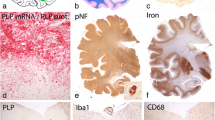Summary
The early histological changes in the CNS, functional state of the blood-brain barrier, production of humoral anti-brain immunoglobulins and immunohistological changes in myelin sheaths have been studied in two groups of guinea pigs inoculated with encephalitogenic antigens (basic protein, homologous and heterologous brain) mixed with two different doses of adjuvant. All antigens mixed with a low dose of adjuvant induced histological changes in about 20% of the animals. The blood-brain barrier was not or only slight disturbed. Antigens mixed with a high dose of adjuvant provoked severe EAE in 95% of the animals. The blood-brain-barrier displayed multiple injuries with diffusion of anti-brain antibodies into the nervous tissue. Antibody production showed no significant dependence on the different antigens and the various doses of adjuvant. The immunohistological examination using antibasic protein serum revealed the abolition of fluorescence within areas of inflammatory infiltrates and/or within areas of diffusion of antibodies. The perivascular accumulation of basic protein occurs early preceding the formation of perivascular infiltrates. It is proposed that this probably endogenous basic protein represents the first target structure, which can easily be trapped by circulating sensitized lymphocytes and/or antibodies. In this way it acts as a trigger of early lesions in EAE.
Similar content being viewed by others
References
Alvord, E. C., Jr.: Acute disseminated encephalomyelitis and “allergic” neuro-encephalopathies. In: Handbook of Clinical Neurology, Vol. 9, pp. 500–571. P. J. Vinken and G. W. Bruyn, Eds. Amsterdam: North-Holland Publ. Comp. 1970
Åström, K. E.: Early changes in allergic encephalomyelitis in rabbits. Acta path. microbiol. scand.59, 39–44 (1963)
Field, E. J.: The early lesions of experimental “allergic” encephalomyelitis. Exp. Neurol.4, 233–240 (1961)
Field, E. J., Raine, C. S.: Experimental allergic encephalomyelitis. An electronmicroscopic study. Amer. J. Path.49, 537–554 (1966)
Field, E. J., Raine, C. S.: Experimental allergic encephalomyelitis in rhesus monkey. An electronmicroscopic study. J. neurol. Sci.8, 397–411 (1969)
Hruby, S., Alvord, E. C., Jr.: Personal communication.
Lee, J. M., Schneider, H. A.: Critical relationships between constituents of the antigen-adjuvant emulsion affecting experimental allergic encephalomyelitis in a completely susceptible mouse genotype. J. exp. Med.115, 157–168 (1961)
Levine, S.: Localisation of allergic encephalomyelitis in lesions of cyanide encephalopathy. J. Neuropath. exp. Neurol.19, 238–247 (1960).
Levine, S., Wenk, E. S.: Studies on the metabolism of altered susceptibility to experimental allergic encephalomyelitis. Amer. J. Path.39, 419–441 (1961)
Levine, S., Hoenig, E. M.: Induced localisation of allergic adrenalitis and encephalomyelitis at sites of thermal injuries. J. Immunol.400, 1310–1318 (1968)
Levine, S., Sowinski, R.: Reduction of allergic encephalomyelitis incubation period to 5 days. Amer. J. Path.56, 97–110 (1969)
Luse, S. A., McDougal, D. B.: Electron microscopic observations on allergic encephalomyelitis in the rabbit. J. exp. Med.112, 735–742 (1960)
Munder, P. G., Ferber, E., Modolell, M., Fischer, H.: The influence of various adjuvants on metabolism of phospholipids in macrophages. Int. Arch. Allergy36, 117–128 (1969)
Oldstone, M. B. A., Dixon, F. J.: Early events in allergic encephalomyelitis. Trans. Amer. neurol. Ass.93, 257–259 (1968)
Shaw, C. M., Fahlberg, W. J., Kies, M. W., Alvord, E. C., Jr.: Suppression of experimental allergic encephalomyelitis in guinea pigs by encephalitogenic proteins extracted from homologous brain. J. exp. Med.111, 171–180 (1960)
Shaw, C. M., Alvord, E. C., Fahlberg, W. J., Jr., Kies, M. W.: Adjuvant-antigen relationships in the production of experimental “allergic” encephalomyelitis in the guinea pig. J. exp. Med.115, 169–179 (1962)
Smith, M. E.: Myelin metabolism in vitro in experimental allergic encephalomyelitis. J. Neurochem.16, 1099–1104 (1969)
Waksman, B. H., Adams, R. D.: A histological study of early lesions in EAE in the guinea pig and rabbit. Amer. J. Path.41, 135–162 (1962)
Author information
Authors and Affiliations
Rights and permissions
About this article
Cite this article
Simon, J., Anzil, A.P. Immunohistological evidence of perivascular localization of basic protein in early development of experimental allergic encephalomyelitis. Acta Neuropathol 27, 33–42 (1974). https://doi.org/10.1007/BF00687238
Received:
Accepted:
Issue Date:
DOI: https://doi.org/10.1007/BF00687238



